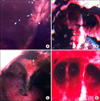Abstract
Activated charcoal is an inert substance and it is used in standard therapy in patients with acute intoxication. Charcoal has some side effects such as pulmonary aspiration, gastrointestinal complications, and electrolyte abnormalities. Although aspiration of charcoal is a rare complication, it can cause fatal sequelae. We report a 69-year old man who developed acute respiratory failure associated with charcoal aspiration after management of glyphosate poisoning. The patient was drowsy and suffered severe vomiting during transport to our hospital. On arrival, acute respiratory failure was observed due to charcoal aspiration, but the clinical state was improved with repeated bronchoscopy with a bronchoalveolar lavage (BAL). We presumed that the aspirated charcoal was an important factor in evoking a lung injury. Early bronchoscopy with a BAL might be an effective method for eliminating charcoal from the lung, especially in the case of a large amount of aspiration, and be helpful in decreasing respiratory failure due to charcoal aspiration.
Figures and Tables
Figure 1
Serial change of patient's chest radiogram. (A) Initial x-ray in the emergency room shows an infiltration in left lung, right upper lung and right lower lung. (B) X-ray after bronchoalveolar lavages for three consecutive days shows that the infiltrations in left lower lung, right upper lung and right lower lung were improving. (C) Follow up x-ray at 20th day after charcoal aspiration shows the infiltrations in left lung were almost clear.

Figure 2
Bronchoscopic findings of patient before and after bronchoalveolar lavage (BAL). (A, B) Black foreign materials, which were thought to be aspirated charcoal, on bronchial mucous membrane at the first visit. (C, D) Cleaned bronchial mucous membrane after BAL procedures. Arrows show charcol. Arrows shows charcol (A, C: carina; B, D: LLL Basal). LLL: left lower lobe.

References
1. Francis RC, Schefold JC, Bercker S, Temmesfeld-Wollbrück B, Weichert W, Spies CD, et al. Acute respiratory failure after aspiration of activated charcoal with recurrent deposition and release from an intrapulmonary cavern. Intensive Care Med. 2009. 35:360–363.
2. American Academy of Clinical Toxicology. European Association of Poisons Centres and Clinical Toxicologists. Position statement and practice guidelines on the use of multi-dose activated charcoal in the treatment of acute poisoning. J Toxicol Clin Toxicol. 1999. 37:731–751.
3. Elliott CG, Colby TV, Kelly TM, Hicks HG. Charcoal lung. Bronchiolitis obliterans after aspiration of activated charcoal. Chest. 1989. 96:672–674.
4. Knaus WA, Draper EA, Wagner DP, Zimmerman JE. APACHE II: a severity of disease classification system. Crit Care Med. 1985. 13:818–829.
5. Nam HS, Park MR, Park SY, Lim SY, Kim SA, Song JU, et al. A preliminary study on the effect of "low-dose" glucocorticoid therapy for patients with persistent acute respiratory distress syndrome. Korean J Crit Care Med. 2009. 24:80–86.
6. Huber M, Pohl W, Reinisch G, Attems J, Pescosta S, Lintner F. Lung disease 35 years after aspiration of activated charcoal in combination with pulmonary lymphangioleiomyomatosis. A histological and clinicopathological study with scanning electron microscopic evaluation and element analysis. Virchows Arch. 2006. 449:225–229.
7. Seder DB, Christman RA, Quinn MO, Knauft ME. A 45-year-old man with a lung mass and history of charcoal aspiration. Respir Care. 2006. 51:1251–1254.
8. Kim S, Kang NR, Sohn I, Lee H, Lee YK, Song SH. Acute respiratory distress syndrome with chemical pneumonitis after aspiration of activated charcoal: a case report. Korean J Crit Care Med. 2010. 25:112–117.
9. Roberts DM, Buckley NA, Mohamed F, Eddleston M, Goldstein DA, Mehrsheikh A, et al. A prospective observational study of the clinical toxicology of glyphosate-containing herbicides in adults with acute self-poisoning. Clin Toxicol (Phila). 2010. 48:129–136.
10. Harris CR, Filandrinos D. Accidental administration of activated charcoal into the lung: aspiration by proxy. Ann Emerg Med. 1993. 22:1470–1473.
11. Golej J, Boigner H, Burda G, Hermon M, Trittenwein G. Severe respiratory failure following charcoal application in a toddler. Resuscitation. 2001. 49:315–318.




 PDF
PDF ePub
ePub Citation
Citation Print
Print


 XML Download
XML Download